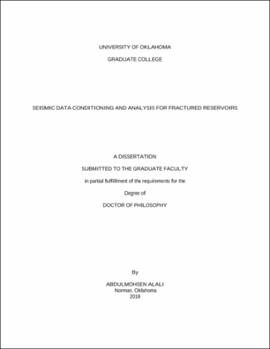| dc.contributor.advisor | Marfurt, Kurt | |
| dc.contributor.author | AlAli, Abdulmohsen | |
| dc.date.accessioned | 2018-09-06T21:08:41Z | |
| dc.date.available | 2018-09-06T21:08:41Z | |
| dc.date.issued | 2018 | |
| dc.identifier.uri | https://hdl.handle.net/11244/301629 | |
| dc.description.abstract | The ability to identify the intensity and orientation of fractures within both unconventional and conventional resources can have a critical impact on oil field development. Fractures and faults are often the primary pathways for hydrocarbon migration and production. Because of their complexity and commercial importance, fractures have been studied by each of the main disciplines – geology, geophysics, petrophysics, and engineering. The focus of this dissertation is to present an understanding of how different geophysical technologies can be used to characterize fractures at different scales. Seismic attributes are one of the main tools to map the distribution of fractures and can be categorized into geometric attributes, azimuthal velocity anisotropy, amplitude variation with offset and azimuth, and diffraction imaging. These categories are complementary to each other and can provide overlapping information. The diversity of the assumptions under each category makes it challenging to bridge the gap for real world applications.
Acquisition footprint overprints most seismic surveys and can mask or in some cases be misinterpreted as underlying faults and fractures. There are two modern trends in imaging the subsurface with high quality 3D seismic surveys. The first is to acquire new high density, high fold, wide azimuth surveys that exhibit less footprint. The second is to combine multiple legacy surveys into “megamerge” (or even “gigamerge” surveys) that exhibit multiple footprint patterns. To address this latter problem, I start my dissertation by introducing an adaptive 2D continuous wavelet transform (CWT) footprint suppression workflow whose design is based on artefacts seen on seismic attributes. Suboptimum seismic acquisition is one of the major causes of acquisition footprint. 5D interpolation (also called 5D regularization) is a modern seismic processing workflow that attempts to fill in the missing offsets and azimuths. I examine the effect of a commercial Fourier-based 5D interpolation on both footprint artefacts and geologic discontinuities measured using seismic attributes. I find that by accurately interpolating specular reflections, 5D interpolation suppresses acquisition footprint and improves the lateral continuity of prestack inversion images of P-impedances. Unfortunately, 5D Fourier-based interpolation incorrectly corrects diffraction events and therefore attenuates faults and karst edges seen in coherence.
Whereas 5D interpolation attempts to enhance the specular component of seismic data, diffraction imaging attempts to enhance the non-specular or diffracted component of the seismic data necessary to image fractures. Although the lateral resolution of diffractions is better than that of specular reflections, closely spaced fractures forming a “fracture swarm” may appear to be a single, larger fracture, while more laterally extensive fracture swarms give rise to azimuthal and offset anisotropy. I investigate each technique’s ability to detect fractures using forward modeling and find that diffraction’s focusing sensitivity to velocity inaccuracies makes it an excellent candidate to highlight close-spaced fractures. I also find that cross-correlating images of diffractions from nearby experiments is useful in constructing an objective function that can be used to update the velocity due in the image domain. I demonstrate the efficiency of these findings using synthetic models with different complexity. Azimuthal and offset anisotropy signature for irregularly spaced fractures is complex and different from the constant fracture spacing approximated by effective medium theory particularly for reflection below the fractures. I find isotropic amplitude variation modeling give an indication if fractures are located at the bottom portion of the reservoir. | en_US |
| dc.language | en_US | en_US |
| dc.subject | Seismic Data Conditioning | en_US |
| dc.subject | Diffracting Focusing | en_US |
| dc.subject | Fractured reservoirs analysis | en_US |
| dc.subject | 5D interpolation case study | en_US |
| dc.subject | 2D Continuous Wavelet Transform | en_US |
| dc.title | SEISMIC DATA CONDITIONING AND ANALYSIS FOR FRACTURED RESERVOIRS | en_US |
| dc.contributor.committeeMember | Lakshmivarahn, S | |
| dc.contributor.committeeMember | Chen, Xiaowei | |
| dc.contributor.committeeMember | Nakata, Norimitsu | |
| dc.contributor.committeeMember | Rich, Jamie | |
| dc.date.manuscript | 2018-09 | |
| dc.thesis.degree | Ph.D. | en_US |
| ou.group | Mewbourne College of Earth and Energy::Conoco Phillips School of Geology and Geophysics | en_US |
